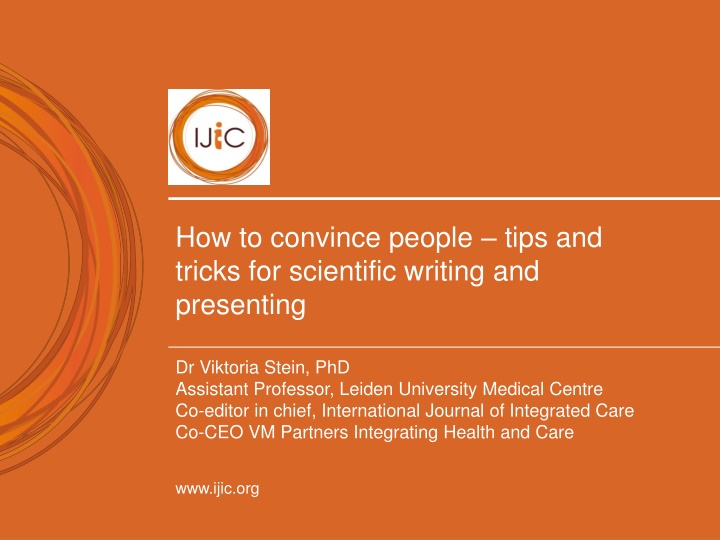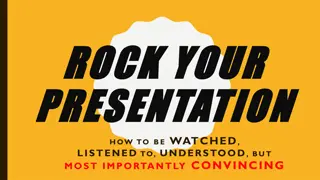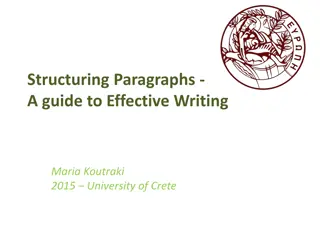Mastering the Art of Convincing: Scientific Writing and Presentation Insights
Delve into the world of scientific writing and presenting with expert tips from Dr. Viktoria Stein, covering the reviewing process, key considerations for articles, and strategies to increase your chances of publication. Learn how to engage reviewers, craft impactful content, and navigate the publishing landscape effectively.
Download Presentation

Please find below an Image/Link to download the presentation.
The content on the website is provided AS IS for your information and personal use only. It may not be sold, licensed, or shared on other websites without obtaining consent from the author.If you encounter any issues during the download, it is possible that the publisher has removed the file from their server.
You are allowed to download the files provided on this website for personal or commercial use, subject to the condition that they are used lawfully. All files are the property of their respective owners.
The content on the website is provided AS IS for your information and personal use only. It may not be sold, licensed, or shared on other websites without obtaining consent from the author.
E N D
Presentation Transcript
How to convince people tips and tricks for scientific writing and presenting Dr Viktoria Stein, PhD Assistant Professor, Leiden University Medical Centre Co-editor in chief, International Journal of Integrated Care Co-CEO VM Partners Integrating Health and Care www.ijic.org A movement for change
The reviewing process explained A movement for change
How does the reviewing process work? Bad science is bad science regardless of whether the study addressed an important clinical issue, whether results are statistically significant , or whether they prove your point (Greenhalgh 2001, p. 39) At IJIC (and many other journals): Editors-in-chief screen and decide, whether article goes into peer review or not At least 2 reviewers, double-blinded, and give recommendations Editors-in-chief decide whether to ask for revisions or reject after review Once accepted, publication in real time A movement for change
What are reviewers looking for in an article? First question to ask: Is it integrated care? Further questions to ask: Why was the study done? What was the hypothesis? What type of study was done? Was this appropriate? Does the study add new findings to the literature? Is it innovative? What was measured? How? Was it appropriate? Was there a follow-up? Was that adequate? What are the lessons learned? Transferability? Scalability? !!!PLEASE, always have a look at the author guidelines BEFORE preparing your article!!! A movement for change
How to increase your chances of getting published A movement for change
Questions to consider before writing an article Who is my audience? Who should get my message? How international is my research? Which research methods did I use? How important is the Impact Factor? Did I comply with the journal s requirements? Which journals are available in my field of research? Do I know someone in the editorial board? Tipps to consider: Always cite articles from the journal you want to publish in! Always cite articles from your own research group! Don t forget to acquire a vote from the ethical commission! A movement for change
How to structure your article? Introduction (Problem/Background) Why is your topic up to date? What is the story behind your research? What is your defined research question? Methods Which method(s) did you use. How did you conduct your research. Results What did you find out? Discussion What is the answer to your research question? What implications do your results have regarding the background and the current literature? How do your findings fit into the context of current literature? Conclusion Are your results transferable to other countries / contexts? What has been achieved by this article? Which (follow-up) questions remain or result from your research? !!!!!!Look at the author guidelines!!!!! https://www.ijic.org/about/submissions/#author-guidelines A movement for change
Common mistakes, which may lead to rejection Overall topic doesn t fit the journal Fuzzy title title promises more than the text delivers Abstract doesn t fit the text Lack of background information (where, why, who) Methods not explained well Discussion too long, no storyline, not based on context literature, too many/too few messages Missing strengths and limitations Conclusion not based on findings, no recommendations for future research A movement for change
Common mistakes: examples Overall topic doesn t fit the journal it never becomes clear what exactly the Primary health care centres (PHCC) are offering as regards the diabetes and hypertension patients and what that has to do with integrated care. In fact, integrated care isn t mentioned once throughout the text. The other findings they present concerning independent predictors do not strike me as new evidence either[ ]The one important message this article has, is, that the health care team plays a pivotal role in the management and control of chronic disease, but no details or new findings are presented. The authors say that one centre stood out concerning the results of their patients but they offer no explanation as to why that is so on the contrary, they claim there are no differences in staff or resources. Overall, it seems a bit disjoint. A movement for change
Common mistakes: examples Lack of background information (where, why, who) The authors describe a research study that considers multiple health domains through a comprehensive school-based intervention. They make a persuasive case why multiple domains should be considered and describe the detail of their project. However, this manuscript is very confusing as to whether this project is complete or not complete. Clearly the authors intend to use this article to explain their methods and others to explain their outcomes, but they alternate considerably between past, present, and future tenses in describing this study, making it very confusing to follow the status of their project. If the project is complete, it would be nice to hear how well the expected methods worked. If the project is not underway (unlikely since they describe it starting in 2005), the authors should stick to the future tense in describing their plans. If the project is still currently underway, perhaps the authors can give us insight into how it is going so far, including successes and challenges. A movement for change
Common mistakes: examples Methods not explained well The article also has some methodological deficiencies where a clearer motivation why content analysis was used is needed. Also the level of transcription (verbatim) is not motivated why it was chosen. Working with natural occurring data, such as this, has a number of strengths and weaknesses that must be taken into account se for example Speer, S. (2007). Natural and contrived data. In Alasuutari, P., Brannen, J. & Bickman, L. (eds.). The handbook of social research. London: Sage. Creating expectations that are not met e.g. Promising a practice example that is never described or substituted by a virtual example. Failing to deliver on the aims set forth in the introduction. Strengths and limitations Correct form: Sandwich formate similar to correct feedback formula A movement for change
Common mistakes: examples Discussion too long, no story line, not based on context literature, too many/too few messages Conclusion not based on findings, no recommendations for future research The aim described in the intro and the results in the discussion and conclusion sections do not correspond. In the introduction it is laid out that the article will explore why Quality Management is a part of Risk Management and not the other way round, as stated in the literature. In the Results and Conclusion sections, however, the authors very convincingly state the commonalities of QM and RM and rather argue for an integrated approach. The aim to prove that QM is a part of RM is not reached, and only mentioned in a sideline, mentioning a new ISO guideline. Moreover, the authors contradict their own aim in the text. For the article proving the aim would not even be necessary, because it actually argues very convincingly that an integrated QM/RM is sensible, important and advantageous. A movement for change
How to please the editor/reviewer? Aims and motivations of an editor: Raise the impact factor Attract renown names Publish high impact articles Raise awareness/money for the journal Aims and motivations of a reviewer: Help colleagues to improve a manuscript Give advice Recommend own literature Stay up to date with what s going on A movement for change
Specifics to consider for conference abstracts Conveys a convincing story in limited words Needs to stick to overall structure of article/conference prerequisites Focus on the essential: what are the key messages of your article/work/presentation? Needs to achieve 2 aims: Clearly state what was done Incite interest to learn more A movement for change
How to give a convincing presentation A movement for change
Before you start What is the aim of my presentation? Conference, project proposal, PhD thesis, Who am I speaking to? Colleagues, students, scientific audience, potential project partners, mixed audience What are my key messages? What do I want the audience to do after my presentation? Discussion / Ask questions Take home (a) message Get in contact with me Remember me A movement for change http://www.marketlikeachick.com/wp-content/uploads/2010/04/Tell-Your-Story-300x299.jpg
How to prepare the presentation What is your story? Clear narrative is most important: make sure you have a good story board Tell the key facts leave the rest! Different kinds of stories: present scientific study teaching a class presenting a proposal How much are you willing to invest? What should be the impact? Make sure your audience is able to understand you Language, content, humor !! http://astoriedcareer.com/MyStory.jpg A movement for change
How to build an effective presentation Keep in mind: You want the audience to pay attention Raise curiosity Find something surprising/ interesting/unorthodox http://edubuzz.org/drama/files/2010/06/tension-one.jpg A movement for change
How to prepare the slideshow Never ever present slides you have to apologise for! Never ever apologise for your slides! Slides should be a visual help for your talk Be very careful with animations Be careful with figures and tables: Danger of losing the audience Give it a context and keep it easy Walk your audience through the data and explain what is going on http://cdn.blogsdna.com/wp-content/uploads/2009/12/Slideshow-Icon.png A movement for change
How to prepare the slideshow Rules of thumb (for conference presentations): Not more than 5 bullets or 8 lines 1 slide = 1 minute Not more than 3 colors No full sentences The simpler the design, the better http://cdn.blogsdna.com/wp-content/uploads/2009/12/Slideshow-Icon.png A movement for change
The time has come... In Advance Practice your presentation with volunteers Be in time and make sure the laptop, presenter, etc is working Find the session chair, introduce yourself and ask how they will organise the session Take a look at how the presentation actually looks on the screen Make yourself familiar with the room http://www.sportmentalcoaching.info/images/Haende-klatschend.jpg A movement for change
The time has come... Let s go You can only be convincing, if you re convinced! Tell your story! Know what is on your slides! Stand up, speak clearly and slowly! Don t be afraid of questions! Earn yourself applause ;-)! http://www.sportmentalcoaching.info/images/Haende-klatschend.jpg A movement for change
Never forget to ... Introduce yourself (unless this was done by the chair) Manage your own time Prepare how and where to cut, if necessary Have a last sentence that clearly signals you re done Think of likely questions and adequate responses For confident presenters: refer to relevant issues discussed in prior presentations or panels http://www.sportmentalcoaching.info/images/Haende-klatschend.jpg A movement for change
Finally... Being nervous is ok, but you needn t be scared. Don t be afraid of questions! YOU ARE THE EXPERT! Practice makes perfect. http://www.sportmentalcoaching.info/images/Haende-klatschend.jpg A movement for change
Helpful literature Punch KF. Introduction to Social Research. Quantitative and Qualitative Approaches. 3rd edition SAGE Publications 2014. Punch KF. Developing Effective Research Proposals. 3rd edition SAGE Publications 2016. Aveyard H. Doing a Literature Review in Health and Social Care. A Practical Guide. 4th edition Open University Press 2018. Greenhalgh T. How to Read a Paper. The basics of evidence-based medicine and health care. 6th edition Wiley-Blackwell 2019. A movement for change























